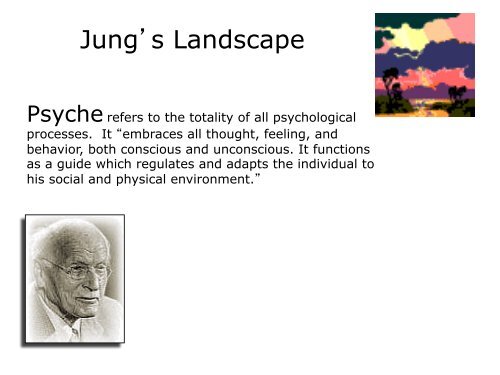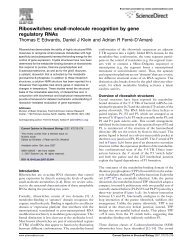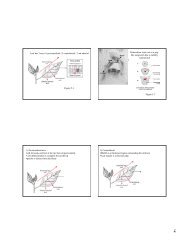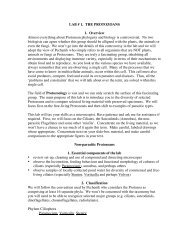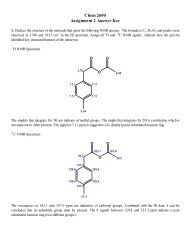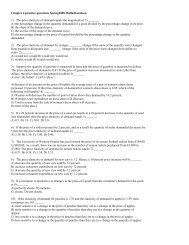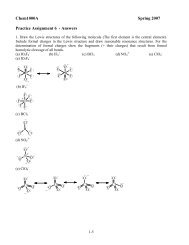The Persona and Shadow.pdf
The Persona and Shadow.pdf
The Persona and Shadow.pdf
You also want an ePaper? Increase the reach of your titles
YUMPU automatically turns print PDFs into web optimized ePapers that Google loves.
Jung’s L<strong>and</strong>scape<br />
Psyche refers to the totality of all psychological<br />
processes. It “embraces all thought, feeling, <strong>and</strong><br />
behavior, both conscious <strong>and</strong> unconscious. It functions<br />
as a guide which regulates <strong>and</strong> adapts the individual to<br />
his social <strong>and</strong> physical environment.”
Jung's Model of the Psyche<br />
ego<br />
Ego-Self Axis<br />
<strong>Persona</strong>l<br />
unconscious<br />
consciousness<br />
C<br />
A<br />
A<br />
Self<br />
A<br />
A<br />
C<br />
collective<br />
unconscious<br />
C<br />
C<br />
A<br />
A<br />
C<br />
C<br />
A=Archetype<br />
C=Complex<br />
Adapted from Stevens, 1990, pg. 29
¡ In becoming civilized, we compromise between our <br />
natural inclinations, instincts, <strong>and</strong> the patterns of <br />
society – what is required <br />
§ One’s public self <br />
§ <strong>The</strong> mask we wear <br />
§ We have many masks or can have
¡ <strong>The</strong> persona is oriented toward society in two <br />
ways <br />
§ We create a mask(s) based on what society <br />
expects of us <br />
▪ Think about the masks you have worn from <br />
kindergarten to now… <br />
§ Why have we worn these?
¡ We wear a mask to meet our own <br />
expectations to get society to look at us in a <br />
particular way! <br />
¡ How about here today in the classroom? <br />
¡ What <strong>Persona</strong> are you portraying right now?
¡ Jung reporting in Singer pg. 159 <br />
“When we analyze the persona we strip off the mask, <br />
<strong>and</strong> discover that what seemed individual is at bottom <br />
collective; in other words, that the persona was only a <br />
mask for the collective psyche. Fundamentally the <br />
persona is nothing real… In a certain sense all this is <br />
real, yet in relation to the essential individuality of the <br />
person concerned it is only a secondary reality, a <br />
product of compromise, in making which others often <br />
have a greater share than he”.
¡ <strong>The</strong> <strong>Persona</strong> is nothing but a status symbol! <br />
¡ And the danger is we believe that “I” am that! <br />
¡ This may work well enough until something <br />
happens to change or damage the mask that <br />
interposed between the reality of the person <br />
<strong>and</strong> the desired image. <strong>The</strong>n the person may <br />
begin to wonder, “Who am I”.
Let’s Meet <strong>The</strong> <strong>Shadow</strong>
R.D. Laing<br />
<strong>The</strong> Other Within Us… <br />
“<strong>The</strong> range of what we think <strong>and</strong> do is limited by what we fail to notice. And<br />
because we fail to notice that we fail to notice there is little we can do to<br />
change until we notice how failing to notice shapes our thoughts <strong>and</strong> deeds”
¡<br />
“Within each woman <strong>and</strong> man, the dim <br />
cavern of the unconscious holds our <br />
forbidden feelings, secret wishes, <strong>and</strong> <br />
creative urges. Over time, these ‘dark’ <br />
forces take on a life of their own, forming <br />
an intuitively recognizable figure – the <br />
<strong>Shadow</strong>. A recurring theme in literature <br />
<strong>and</strong> legend, the <strong>Shadow</strong> is like an invisible <br />
twin, a stranger that is us, yet is not us. <br />
When it acts out in the public domain, we <br />
witness our leaders, like hero-‐villains, fall <br />
from grace in sc<strong>and</strong>al. Closer to home, <br />
we may feel overcome with rage, <br />
obsession, <strong>and</strong> shame or succumb to self-destructive<br />
lies, addiction, <strong>and</strong> <br />
depression. <strong>The</strong>se appearances of the <br />
<strong>Shadow</strong> introduce us to the Other, a <br />
powerful force that defies our efforts to <br />
tame <strong>and</strong> control it.” <br />
(Zweig)
¡<br />
“[<strong>The</strong> <strong>Shadow</strong>] is everything in us that is <br />
unconscious, repressed, undeveloped <strong>and</strong> denied. <br />
<strong>The</strong>se are dark rejected aspects of our being as <br />
well as light, so there is positive undeveloped <br />
potential in the <strong>Shadow</strong> that we don’t know about <br />
because anything that is unconscious remains <br />
hidden from our active conscious mind… <br />
A confrontation with the <strong>Shadow</strong> is essential for <br />
self awareness. We cannot learn about ourselves if <br />
we do not learn about our <strong>Shadow</strong>, so, therefore, <br />
we are going to attract it through the mirrors of <br />
other people.” <br />
(Eigen).
¡ “<strong>The</strong> <strong>Shadow</strong> is difficult to perceive <br />
consciously. Since an individual will <br />
deny or ignore his or her <strong>Shadow</strong> side, <br />
it is likely that it will be projected onto <br />
others. Instead of acknowledging their <br />
<strong>Shadow</strong>, the individual will <br />
unconsciously see it in people they <br />
encounter or even concepts, objects, <br />
ethics or groups... <strong>The</strong>se characteristics <br />
that we find hideous in other people <br />
could in fact be our own repressed <br />
attributes… [we have] stumbled upon <br />
parts of…[our] own <strong>Shadow</strong>.” <br />
(Wilson)
In literature <strong>and</strong> film, often the hero’s <strong>Shadow</strong> is embodied within a foil character. <br />
But not every hero/villain pairing is a true <strong>Shadow</strong> relationship. When the hero’s <br />
darker side exists within another character, there must also be a strong surface <br />
connection evident between the protagonist <strong>and</strong> antagonist. <strong>The</strong>y are similar, but <br />
disparate. <strong>The</strong> similarities pull them together as the differences tear them asunder.
Within the Batman film <strong>The</strong> Dark Knight, the co-‐dependent relationship between hero <br />
<strong>and</strong> villain, light <strong>and</strong> dark, is pushed to center stage. <strong>The</strong> Joker repeatedly states that <br />
the existence of Batman spurned the creation of the Joker, that each operates against <br />
<strong>and</strong> because of the other. Every coin needs two sides <strong>and</strong> although the Joker states it <br />
flippantly, there is a meaningful subtext when he says to Batman, “You complete <br />
me.”
<strong>The</strong> Stars Wars universe is chock-‐full of deliberate archetypes. <strong>The</strong> <strong>Shadow</strong> is no exception. <strong>The</strong> <br />
promotional image to the left directly speaks to the fact that Anakin Skywalker will eventually grow <br />
up to be swallowed by his <strong>Shadow</strong>; he will fall <strong>and</strong> rise anew as the black-‐hearted Darth Vader. His <br />
literal shadow foreshadows the eventual power his psychological <strong>Shadow</strong> will possess. <strong>The</strong> <br />
promotional image on the right again highlights this duality, within Anakin, of both light <strong>and</strong> dark. <br />
Tatters of the left portion remain human, but the majority of his face is covered in robotic darkness.
In Tolkien’s Lord of the Rings trilogy, a complex system of Self <strong>and</strong> <strong>Shadow</strong> is established. <strong>The</strong>re are many surface <br />
similarities between the halfling hero Frodo <strong>and</strong> his shadowy counterpart Gollum. Frodo Baggins is a hobbit, the <br />
type of creature Gollum used to be. Both have intimate knowledge of the pain <strong>and</strong> power associated with the role <br />
of a ring-‐bearer. But Frodo has not yet been completely overcome by his <strong>Shadow</strong> while Gollum has almost been <br />
defeated by the darkness within. Even within this <strong>Shadow</strong> representative, there is a further split between good <br />
<strong>and</strong> evil. Gollum has two distinct personalities bearing several differing names – Smeagol/Slinker still remembers <br />
shreds of his humanity while Gollum/Stinker no longer yearns for the touch of interior sunlight.
¡ http://www.youtube.com/watch?<br />
v=wxN2Mewamj0 <br />
¡ http://www.youtube.com/watch?<br />
v=DLvIFRNbqOs
¡<br />
¡<br />
¡<br />
¡<br />
Eigen, Rebecca. "<strong>The</strong> <strong>Shadow</strong> Dance – Underst<strong>and</strong>ing Repetitive Patterns in <br />
Relationships.” <strong>Shadow</strong>Dance.com. 09 June 2009. <strong>Shadow</strong>Dance Unlimited. 27 Aug <br />
2009 . <br />
Jung, C. G.. <strong>The</strong> Archetypes <strong>and</strong> the Collective Unconscious. 2 nd ed. New York: <br />
Princeton University Press, 1959. Print. <br />
Wilson, Kevin. "Confrontation With the <strong>Shadow</strong>.“ Insomnium.com. 27 Aug 2009 <br />
. <br />
Zweig, Connie, <strong>and</strong> Steve Wolf. Romancing the <strong>Shadow</strong>: Illuminating the Dark Side of the <br />
Soul. New York: Simon & Shuster, 1997. Print.


